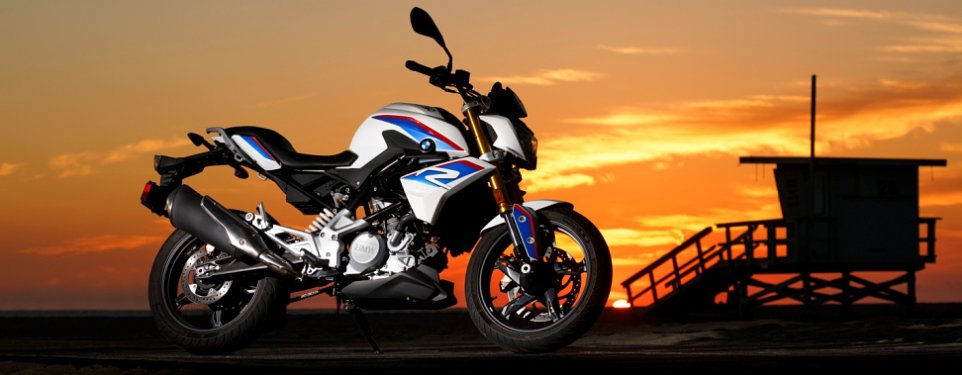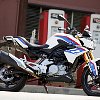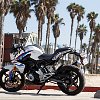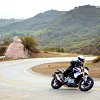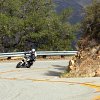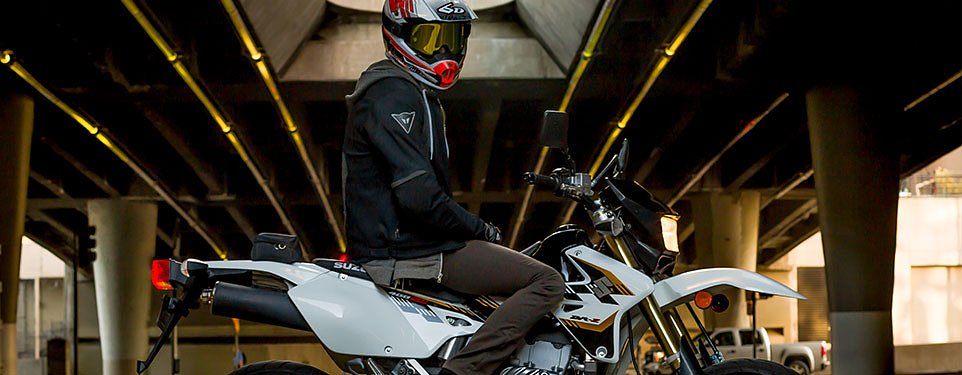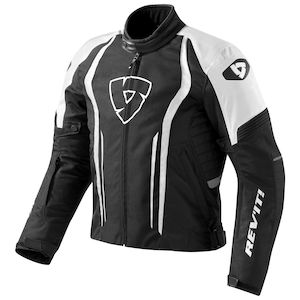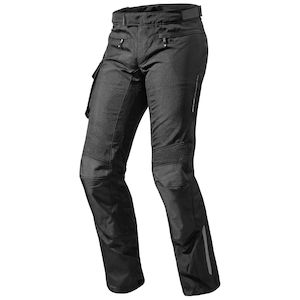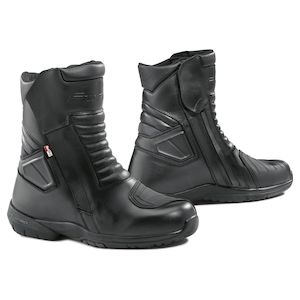As I plunged down the mountainside on Decker Canyon Road near Malibu, California, sunshine poured through a gap in the clouds and the first view of the Pacific in hours threatened to distract me from the quickly approaching hairpin. It occurred to me: There’s something wrong with this picture.
The pavement was new and perfectly smooth, the scenery gorgeous, and the BMW G 310 R nimble and light beneath me, helping me survive the hairpin, despite the distraction. I was happy to be riding the bike on such a perfect road. The motorcycle is certainly capable there. But the winding asphalt of the Santa Monica Mountains is not where this smallest BMW is going to earn its stripes.

The G 310 R will find success if it proves itself in the traffic muddle of Mumbai, the potholes of Sao Paulo, or closer to home for us, lanesplitting through the grind of the 405 here in Southern California, where BMW introduced the bike to the world press this week.
Initially, I was surprised that a model aimed mainly at world markets was introduced at a trendy hotel near Hollywood. In fact, when BMW announced the bike a full year ago, I wasn’t even sure it would come to the U.S. market. But BMW execs say they know what they’re doing.

“In the beginning, the idea for the bike was to get into new markets for us, countries like Brazil, India, China,” said BMW Motorrad Head of Design Edgar Heinrich. “They are very different customers, very different markets, of course. But in developing it, we found out there is interest even in these mature markets, like Europe or like America.”
The G 310 R, and the other G models to follow, will play different roles in different markets. In places like Brazil and India (where the motorcycles will be built for BMW by the huge motorcycle manufacturing company TVS Motor Company, on a separate, dedicated production line), this smallest BMW will still be an aspirational model, a premium motorcycle, a step up for riders in the growing middle class. By dropping down to 300 cc, BMW essentially doubles the number of potential buyers it can reach in the world.

At the same time, in markets like Europe and North America, the G 310 R appeals to new riders stepping up to a second bike, or re-entry riders, or urbanites looking for a nimble and affordable mount that still provides a premium feel.
“There are many people who don’t necessarily need a performance bike,” said Heinrich. “They just want to have a nice bike, a premium bike, even in a smaller cc class.”
But enough industry talk. What about the motorcycle?
Key stats on the BMW G 310 R
At first glance, it’s easy to see the family resemblance to the BMW S 1000 R in the radiator shrouds, especially in the white version. Black and blue versions will also be available. The plastic panels over the sides of the slim, 2.9-gallon gas tank are separated by a black, rubbery material in the center that probably makes a tank protector unnecessary.
You can judge the looks for yourself, but the key thing is that the bike does not look cheap. It may be small, but BMW uses the word "premium" frequently when describing the image they want the G 310 R to project. They know skeptics will question it because it is made in India, not Germany. I can tell you that up close and personal, fit and finish are what I expect from any BMW.
Hop aboard and the light weight is immediately noticeable. BMW says 349 pounds, ready to ride. The digital dash includes a gear indicator. The tachometer display is a bar graph across the bottom that’s small but not terribly difficult to read at a glance. A single button lets you toggle through displays of trip meters, fuel range, fuel mileage and engine temperature.

The heart of the G 310 R is the 313 cc fuel-injected, four-valve single, sending a claimed 34 horsepower to the six-speed transmission and chain final drive. BMW reversed the single from the normal configuration, putting the intake in front and the exhaust at the rear and tilting the cylinder backwards slightly. This allowed engineers to move the engine further forward in the steel-tube chassis, make the swingarm longer and keep the weight distribution an even 50 percent on each wheel with a short 54-inch wheelbase. It also makes the exhaust shorter, which helps the catalytic converter heat up faster so the bike can meet emissions standards.
The inverted Kayaba fork looks the business, but is not adjustable. The only suspension tinkering available is preload on the rear shock. ABS is standard, with a single 300 mm disc in front and a 240 mm disc at the rear. Steel braided brake lines are another premium touch.
The standard seat sits 30.9 inches off the pavement and is flat and fairly narrow. With my 32-inch inseam, I could easily flat-foot the bike with my knees bent, so shorter riders should have an easy enough time.
Of course the other key stat is price. BMW set the MSRP at $4,750 and reduced its usual $495 destination and handling fee to $245 to bring the final price down to five bucks under $5,000. The Pearl White Metallic model we rode will carry an as-yet-unspecified extra cost. For those of you wondering, the next 300-class model, the G 310 GS mini-ADV bike, will be priced similarly to the R, BMW execs told us. They said the R will be available at dealers in the summer of 2017, with the GS to follow months later.

First impressions of riding the BMW G 310 R
Our day of riding took us from the streets of Hollywood to the Santa Monica Mountains for a stop at the Rock Store and back into the city: a mix of urban riding, canyon strafing, a bit of highway riding and a fair amount of lanesplitting to get back to the hotel in time for dinner.
The nimble feeling is aided by the relatively narrow tires: 110/70R17 front and 150/60R17 rear. Our test bikes wore Michelin Pilot Street Radials, but production models may come with Michelins, Pirellis or Metzelers. Once we escaped the city traffic into the mountains, I quickly got used to the feel of how easily the bike tipped into the turns. Any suspension with no adjustment is going to be a compromise, but this compromise worked well for my 170 pounds. The suspension did a good job of handling the lumps as we pounded over some rough pavement leaving town. Only once in the mountains, when I hit bumpy asphalt mid-curve, did I start losing track of what the front tire was doing.

The single is happy to rev and you need to get it above 4,000 rpm to begin making anything like brisk progress. Keeping it in the 6,000 to 8,000 rpm range worked for surfing the curves, with trips to the redline as needed. BMW says horsepower peaks at 34 at 9,500 rpm with peak torque of 21 foot-pounds at 7,500. Let’s face it, on a 34-horsepower short-stroke engine, you’re going to rev the piss out of it now and then. The tach seems to indicate that redline is 10,000 rpm, but the spec sheet says 10,500. Somewhere around that latter number, a shift light blinks on and if you keep up the nonsense the rev limiter kicks in fairly abruptly.

The brakes lack any grabbiness that could cause problems for new riders and provided plenty of stopping power for a motorcycle of this size. The ABS kicked in unexpectedly once when I hit some bumps and a painted line while braking. It just did its job, no fuss. And here’s the thing. Light weight solves so many problems. Do you feel a little let down by 34 horsepower? Well, you can still get down the highway at 80 mph because you don’t have that much weight to move. The suspension and brakes don’t have to be the greatest, high-bucks stuff because they don’t have that much weight to suspend or stop.
I’ll be honest and say that unfortunately I have not ridden the main competitors to this bike, like the Honda CB300F (less expensive and less powerful) or the KTM 390 Duke (a little more expensive and powerful), so I can’t provide a comparison. But I will say the BMW exceeded my expectations.
Let me leave you with a vignette. As we were doing our photo shoot on a set of mountain curves, a local rider on a Ducati 1098 decided to insert himself into our rotation, taking off just ahead of a certain writer who has some significant racing experience. By the time he got halfway down the mountain to our turnaround point, the writer had passed the Ducati.
So what have we proved here? That a BMW G 310 R is faster than a Ducati 1098. Sometimes.
So is a BMW G 310 R good enough for you? Are you good enough for the G 310 R? Less skilled riders may need more bike.

Any regrets?
BMW had a difficult balancing act with this bike. It has to be affordable without feeling cheap. Plus, you know some people will say it’s not a “real” BMW because it’s not made in Germany.

In the end, there were only two areas where I saw attributes that felt less than the "premium" tag BMW used so much. First, when I squeezed the tank with my knees, I felt a surprising amount of vibration through the tank, especially in the midrange, around 7,000 rpm, which is right where you want to be spinning the engine for spirited riding. Vibration was minimal in the footpegs, which have rubber inserts, even less yet in the seat, and almost non-existent in the handgrips. For that reason, I don’t think it will be a big problem for most riders.
The other example is a small one most G 310 R owners will never notice. The large rear tail light and the plastic assembly that holds it extends fairly far from behind the seat, so it bounces around a lot over bumps. A G 310 R rider won’t see this, of course – unless, like me, you’re following one all day long. It’s the only thing I can mention that might make a bystander watch a G 310 R ride by and not think “premium motorcycle.”
And those are pretty small complaints, really.
Final thoughts on the BMW G 310 R
As I planned this trip, it all seemed so familiar, so I went back and looked up some old clips of mine. It was almost exactly 15 years ago that BMW invited us to a trendy Hollywood hotel to unveil a new motorcycle intended to reach new customers. It was also BMW’s smallest bike at the time and we rode some of the same roads. That earlier bike was the F 650 CS. Don’t feel bad if you don’t remember it.
Will the G 310 R and the other members of the new G line fare better than the late F 650 CS? I definitely think so, for two reasons. First, BMW wanted about $9,000 for that 650. Second, the real success of the G 310 R and its siblings will not depend on huge sales numbers in North America, but on its success in world markets where a growing middle class will see the BMW as a step up from the locally designed and built motorcycle or scooter they’ve been riding.
After spending a day with the smallest BMW, I think they’ll be pleased.
| BMW G 310 R | |
|---|---|
| Engine type | Liquid-cooled, single-cylinder four-stroke |
| Bore and stroke | 80 mm x 62.1 mm |
| Fuel capacity | 313 cc |
| Power | 34 horsepower @ 9,500 rpm |
| Torque | 21 foot-pounds @ 7,500 rpm |
| Compression ratio | 10.6:1 |
| Maximum speed | Over 90 mph |
| Fuel consumption | 71 mpg |
| Front tire | 110/70R17 |
| Rear tire | 150/60R17 |
| Front brake | Single disc, 300 mm, four-piston fixed caliper |
| Rear brake | Single disc, 240 mm, single-piston floating caliper |
| Length | 78.9 inches |
| Height | 42.5 inches |
| Seat height (Standard) | 30.9 inches |
| Weight | 349 pounds |
| Tank volume | 2.9 gallons |
| Front suspension travel | 5.5 inches |
| Rear suspension travel | 5.2 inches |
| Wheelbase | 54.0 inches |
| Clutch | Multi-plate wet clutch |































 Riders Preferred Membership
Riders Preferred Membership
